|
News Archive: March 1-31 |

|
Soyuz ferries three-man crew to the space station
Russian commander Pavel Vinogradov, NASA flight engineer Jeffrey Williams and Brazilian astronaut Marcos Pontes docked with the international space station late Friday, two days after blastoff Wednesday from the Baikonur Cosmodrome in Kazakhstan.
 FULL STORY FULL STORY
 |  |

|
 |

Additional coverage for subscribers:
 VIDEO:
SOYUZ DOCKS TO THE SPACE STATION PLAY VIDEO:
SOYUZ DOCKS TO THE SPACE STATION PLAY
 MORE: EXPEDITION 13 VIDEO INDEX MORE: EXPEDITION 13 VIDEO INDEX
 SUBSCRIBE NOW SUBSCRIBE NOW

|
Mars Reconnaissance Craft begins adjusting orbit
NASA's Mars Reconnaissance Orbiter has begun a crucial six-month campaign to gradually shrink its orbit into the best geometry for the mission's science work. This period of "aerobraking" uses friction with the tenuous upper atmosphere to transform the spacecraft's very elongated 35-hour orbit to the nearly circular two-hour orbit needed for the mission's science observations.
 FULL STORY FULL STORY
 |  |

|
 |
New map of Milky Way charts where stars are born
A team of astronomers from Boston University's Institute for Astrophysical Research has produced the clearest map to-date of the giant gas clouds in the Milky Way that serve as the birthplaces of stars. Using a powerful telescope, the astronomers tracked emissions of a rare form of carbon monoxide to chart a portion of our home galaxy and its star-forming molecular clouds.
 FULL STORY FULL STORY
 |  |

|
 |
New Horizons payload gets high marks on early tests
In-flight checks of the New Horizons science payload are going well, as six of the seven instruments on board have completed tests proving they survived launch and demonstrated their basic functionality.
 FULL STORY FULL STORY
 |  |
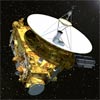
|
 |
Sea levels may be rising faster than expected
Ice sheets across both the Arctic and Antarctic could melt more quickly than expected this century, according to two studies that blend computer modeling with paleoclimate records.
 FULL STORY FULL STORY
 |  |

|
 |
New resident crew rockets toward the space station
A Russian Soyuz rocket blasted off from the Baikonur Cosmodrome Wednesday and streaked into orbit, carrying a fresh two-man space station crew and a Brazilian test pilot making his nation's first trip off planet.
 FULL STORY FULL STORY
 MISSION STATUS CENTER MISSION STATUS CENTER
 VIDEO: FULL COVERAGE VIDEO: FULL COVERAGE
 |  |

|
 |

Additional coverage for subscribers:
 VIDEO:
LAUNCH OF EXPEDITION 13! PLAY VIDEO:
LAUNCH OF EXPEDITION 13! PLAY
 VIDEO:
FULL ASCENT VIDEO FROM LIFTOFF TO ORBIT PLAY VIDEO:
FULL ASCENT VIDEO FROM LIFTOFF TO ORBIT PLAY
 VIDEO:
REPLAY FROM LAUNCH CAMERA 1 PLAY VIDEO:
REPLAY FROM LAUNCH CAMERA 1 PLAY
 VIDEO:
REPLAY FROM LAUNCH CAMERA 2 PLAY VIDEO:
REPLAY FROM LAUNCH CAMERA 2 PLAY
 VIDEO:
REPLAY FROM LAUNCH CAMERA 3 PLAY VIDEO:
REPLAY FROM LAUNCH CAMERA 3 PLAY
 VIDEO:
REPLAY FROM LAUNCH CAMERA 4 PLAY VIDEO:
REPLAY FROM LAUNCH CAMERA 4 PLAY
 VIDEO:
POST-LAUNCH INTERVIEW WITH ISS MANAGER PLAY VIDEO:
POST-LAUNCH INTERVIEW WITH ISS MANAGER PLAY
 VIDEO:
COMMENTS FROM NASA ASSOCIATE ADMINISTRATOR PLAY VIDEO:
COMMENTS FROM NASA ASSOCIATE ADMINISTRATOR PLAY

 VIDEO:
CREW DEPARTS SUITUP BUILDING FOR LAUNCH PAD PLAY VIDEO:
CREW DEPARTS SUITUP BUILDING FOR LAUNCH PAD PLAY
 VIDEO:
LAUNCH MORNING TRADITIONS AT CREW QUARTERS PLAY VIDEO:
LAUNCH MORNING TRADITIONS AT CREW QUARTERS PLAY
 VIDEO:
THE SOYUZ ROCKET IS ROLLED TO LAUNCH PAD PLAY VIDEO:
THE SOYUZ ROCKET IS ROLLED TO LAUNCH PAD PLAY
 VIDEO:
ROCKET IS ERECTED ON PAD PLAY VIDEO:
ROCKET IS ERECTED ON PAD PLAY
 VIDEO:
PRE-FLIGHT MISSION BRIEFING DIAL-UP | BROADBAND VIDEO:
PRE-FLIGHT MISSION BRIEFING DIAL-UP | BROADBAND
 VIDEO:
CREW'S PRE-FLIGHT BRIEFING DIAL-UP | BROADBAND VIDEO:
CREW'S PRE-FLIGHT BRIEFING DIAL-UP | BROADBAND
 MORE: EXPEDITION 13 VIDEO INDEX MORE: EXPEDITION 13 VIDEO INDEX
 SUBSCRIBE NOW SUBSCRIBE NOW

|
Cassini finds football-field sized moonlets at Saturn
New observations of propeller-shaped disturbances in Saturn's A ring indicate the presence of four small, embedded moons -- and most likely millions more. The discovery could lead to a better
understanding of the origin and formation of Saturn's rings and the solar system as a whole.
 FULL STORY FULL STORY
 |  |

|
 |
Space shuttle engineers assess new wiring issue
Initial wind tunnel tests indicate recent modifications to the foam insulation on the shuttle's external tank may not be as easily analyzed as initially hoped, sources say. While additional testing may resolve the matter, showing the removal of wind deflectors called PAL ramps from the tank will not compromise safety, other ongoing technical issues, including a new concern about possible circuit board wiring problems, threaten the July 1 target date for the next shuttle mission.
 FULL STORY FULL STORY
 |  |

|
 |
Mars meteorite similar to bacteria-etched Earth rocks
A new study of a meteorite that originated from Mars has revealed a series of microscopic tunnels that are similar in size, shape and distribution to tracks left on Earth rocks by feeding bacteria. The finding adds intrigue to the search for life beyond Earth.
 FULL STORY FULL STORY
 |  |

|
 |
NASA restarts once-dead Dawn asteroid mission
Less than a month after falling victim to budget and technical concerns, the Dawn asteroid explorer was brought back from the grave Monday by a decision to restore funding to the mission and launch the probe by next summer.
 FULL STORY FULL STORY
 NASA STATEMENT NASA STATEMENT
 |  |

|
 |

Additional coverage for subscribers:
 AUDIO:
NASA ANNOUNCES DAWN RESTARTED QUICKTIME | FOR IPOD AUDIO:
NASA ANNOUNCES DAWN RESTARTED QUICKTIME | FOR IPOD
 SUBSCRIBE NOW SUBSCRIBE NOW

|
From Europa to lab: New oxygen recipe on icy moons
Some may be surprised to learn that bleach-blondes and the enabler of life elsewhere in our solar system have something in common. It is, in fact, hydrogen peroxide.
 FULL STORY FULL STORY
 |  |

|
 |
Cannibal stars like their food hot, XMM-Newton finds
The European Space Agency's XMM-Newton observatory has seen vast clouds of superheated gas, whirling around miniature stars and escaping from being devoured by the stars' enormous gravitational fields - giving a new insight into the eating habits of the galaxy's "cannibal" stars.
 FULL STORY FULL STORY
 |  |

|
 |
Mars Reconnaissance Orbiter takes test images
The first test images of Mars from NASA's newest spacecraft provide a tantalizing preview of what the orbiter will reveal when its main science mission begins next fall.
 FULL STORY FULL STORY
 |  |

|
 |
Fuel leak apparently doomed Falcon 1 rocket
Early insights from investigators examining Friday's failed launch of the first SpaceX Falcon 1 rocket suggest a fuel leak triggered a fire that ultimately brought down the booster, the company's founder said Saturday.
 FULL STORY FULL STORY
 MISSION STATUS CENTER MISSION STATUS CENTER
 |  |

|
 |
First SpaceX rocket launch ends in failure
The maiden flight for a new breed of low-cost rockets designed to revolutionize the space launch industry met a disastrous fate Friday, tumbling out of control and slamming into the Pacific Ocean moments after liftoff.
 FULL STORY FULL STORY
 |  |

|
 |
New class of comets may be source of Earth's water
Three icy comets orbiting among the rocky asteroids in the main asteroid belt between Mars and Jupiter may hold clues to the origin of Earth's oceans. The newly discovered group of comets, dubbed main-belt comets, has asteroid-like orbits and, unlike other comets, appears to have formed in the warm inner solar system inside the orbit of Jupiter rather than in the cold outer solar system beyond Neptune.
 FULL STORY FULL STORY
 |  |

|
 |
Chandra finds evidence for quasar ignition
New data from NASA's Chandra X-ray Observatory may provide clues to how quasars "turn on." Since the discovery of quasars over 40 years ago, astronomers have been trying to understand the conditions surrounding the birth of these immensely powerful objects.
 FULL STORY FULL STORY
 |  |

|
 |
Sun's exotic neighbor
Astronomers have discovered a unique "brown dwarf" right in our solar neighborhood. If your city were the galaxy, it would be like finding someone you didn't know about living upstairs in your house, one of the discoverers said.
 FULL STORY FULL STORY
 |  |

|
 |
Ideas on gas-giant planet formation take shape
Rocky planets such as Earth and Mars are born when small particles smash together to form larger, planet-sized clusters in a planet-forming disk, but researchers are less sure about how gas-giant planets such as Jupiter and Saturn form.
 FULL STORY FULL STORY
 |  |

|
 |
Tiny probes launched to test advanced technologies
Three trail-blazing satellites were fired into Earth orbit Wednesday morning to prove if TV-sized probes can serve as formation-flying buoys for monitoring the weather of space and the enormous storms spawned by the sun.
 FULL STORY FULL STORY
 MISSION STATUS CENTER MISSION STATUS CENTER
 |  |

|
 |

Additional coverage for subscribers:
 VIDEO:
THIS MORNING'S DEPARTURE FROM VANDENBERG PLAY VIDEO:
THIS MORNING'S DEPARTURE FROM VANDENBERG PLAY
 VIDEO:
LAUNCH PREPS FOR SECOND ATTEMPT PLAY VIDEO:
LAUNCH PREPS FOR SECOND ATTEMPT PLAY

 VIDEO:
WATCH AS FIRST LAUNCH ATTEMPT IS ABORTED PLAY VIDEO:
WATCH AS FIRST LAUNCH ATTEMPT IS ABORTED PLAY
 VIDEO:
THE L-1011 CARRIER AIRCRAFT DEPARTS FOR LAUNCH PLAY VIDEO:
THE L-1011 CARRIER AIRCRAFT DEPARTS FOR LAUNCH PLAY
 VIDEO:
MORNING TAXI TO THE RUNWAY FOR TAKEOFF PLAY VIDEO:
MORNING TAXI TO THE RUNWAY FOR TAKEOFF PLAY
 VIDEO:
THE PRE-LAUNCH NEWS BRIEFING DIAL-UP | BROADBAND VIDEO:
THE PRE-LAUNCH NEWS BRIEFING DIAL-UP | BROADBAND
 VIDEO:
SPACE TECH 5 MISSION PREVIEW DIAL-UP | BROADBAND VIDEO:
SPACE TECH 5 MISSION PREVIEW DIAL-UP | BROADBAND
 SUBSCRIBE NOW SUBSCRIBE NOW

|
Great galactic buddies
Astronomers using NASA's Spitzer Space Telescope have conducted a cosmic safari to seek out a rare galactic species. Their specimens -- clusters of galaxies in the very distant universe -- are few and far between, and have hardly ever been detected beyond a distance of 7 billion light-years from Earth.
 FULL STORY FULL STORY
 |  |

|
 |
Satellites help detect deep-ocean whirlpools
Move over, Superman, with your X-ray vision. Marine scientists have figured out a way to see through the ocean's surface and detect what's below, with the help of satellites.
 FULL STORY FULL STORY
 |  |

|
 |
Speeding up interplanetary communications
MIT researchers have developed a tiny light detector that may allow for super-fast broadband communications over interplanetary distances. Currently, even still images from other planets are difficult to retrieve.
 FULL STORY FULL STORY
 |  |

|
 |
OTHER HEADLINES Additional stories today
|
 |
Loral Skynet re-enters North American FSS market -- Loral Skynet announced Monday it has resumed offering fixed satellite services (FSS) to customers in North America. Pursuant to the terms of Loral's agreement to sell certain of its North American assets to Intelsat in March 2004, Skynet was precluded from offering basic FSS capacity leasing services in North America for two years.
|
 |
Station crew gets away for short trip in Soyuz capsule
The International Space Station's two-man crew took a little drive aboard a Soyuz spacecraft Monday, leaving their orbital home for a short time while moving the capsule from one docking port to another in preparation for visitors due next week.
 FULL STORY FULL STORY
 |  |

|
 |

Additional coverage for subscribers:
 VIDEO:
SOYUZ UNDOCKS FROM THE SPACE STATION PLAY VIDEO:
SOYUZ UNDOCKS FROM THE SPACE STATION PLAY
 SUBSCRIBE NOW SUBSCRIBE NOW

|
Spacecraft catches stellar 'corpses' by the tail
Tiny stellar 'corpses' have been caught blasting surprisingly powerful X-rays and gamma rays across our galaxy by the European Space Agency's gamma-ray observatory Integral. This discovery links these objects to the most magnetically active bodies in the universe and forces scientists to reconsider just how dead such stellar corpses really are.
 FULL STORY FULL STORY
 |  |

|
 |
Water may not have formed Mars' recent gullies
If you're a scientist studying the surface of Mars, few discoveries could be more exciting than seeing recent gullies apparently formed by running water. And that's what scientists believed they saw in Mars Global Surveyor images five years ago.
 FULL STORY FULL STORY
 |  |

|
 |
New manager for Mars rovers in challenging time
NASA's long-lived Mars rovers demand lots of care as they age and the Martian winter approaches. That is the job for John Callas, the newly named project manager. One of Spirit's six wheels has stopped working. Dragging that wheel, the solar-powered rover must reach a slope where it can catch enough sunshine to continue operating during the Martian winter.
 FULL STORY FULL STORY
 |  |
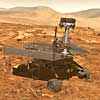
|
 |
Satellite reveals universe's first trillionth second
Scientists peering back to the oldest light in the universe have new evidence for what happened within its first trillionth of a second, when the universe suddenly grew from submicroscopic to astronomical size in far less than a wink of the eye.
 FULL STORY FULL STORY
 |  |

|
 |
Galaxy on fire! Spitzer reveals stellar smoke
Where there's smoke, there's fire -- even in outer space. A new infrared image from NASA's Spitzer Space Telescope shows a burning hot galaxy whose fiery stars appear to be blowing out giant billows of smoky dust. The galaxy, called Messier 82, or the "Cigar galaxy," was previously known to host a hotbed of young, massive stars. Spitzer reveals, for the first time, the "smoke" surrounding those stellar fires.
 FULL STORY FULL STORY
 |  |

|
 |
Weird Saturn ring spokes may return in July
Unusual spokes up to 6,000 miles long and 1,500 miles in width that appear fleetingly on the rings of Saturn only to disappear for years at a time may become visible again by July, according to a new study spearheaded by the University of Colorado at Boulder.
 FULL STORY FULL STORY
 |  |

|
 |
Astronomers get a chance to size up a brown dwarf
Brown dwarfs -- failed stars that fall somewhere between the smallest stars and the largest planets on the spectrum of heavenly objects -- have always been viewed by astronomers as a critical link in the understanding of how both stars and planets form. The trouble with brown dwarfs, however, is that they are hard to find and, so far, they have defied nearly all attempts to accurately assess their size.
 FULL STORY FULL STORY
 |  |

|
 |
Double helix nebula found in center of the Milky Way
Astronomers report an unprecedented elongated double helix nebula near the center of our Milky Way galaxy, using observations from NASA's Spitzer Space Telescope. The part of the nebula the astronomers observed stretches 80 light years in length.
 FULL STORY FULL STORY
 |  |

|
 |
River of stars streams across the northern sky
Astronomers have discovered a narrow stream of stars extending at least 45 degrees across the northern sky. The stream is about 76,000 light-years distant from Earth and forms a giant arc over the disk of the Milky Way galaxy.
 FULL STORY FULL STORY
 |  |

|
 |
Shuttle launch delayed to July 1 for tank sensor swap
The shuttle Discovery's launch on the second post-Columbia mission has been delayed to at least July 1 because of work to replace suspect engine cutoff sensors in the ship's external tank. Shuttle program manager Wayne Hale made the decision Tuesday, after two days of detailed engineering discussions, even though the issue was not an open-and-shut case and even though the sensor in question may be good enough to fly. "This was not an easy decision," Hale told reporters.
 FULL STORY FULL STORY
 NASA STATEMENT NASA STATEMENT
 STS-121: MISSION COVERAGE STS-121: MISSION COVERAGE
 |  |

|
 |

Additional coverage for subscribers:
 VIDEO:
NEWS BRIEFING ON SPACE SHUTTLE LAUNCH DELAY VIDEO:
NEWS BRIEFING ON SPACE SHUTTLE LAUNCH DELAY
DIAL-UP: part 1 and part 2 | BROADBAND: part 1 and part 2

 SUBSCRIBE NOW SUBSCRIBE NOW

|
New planet discovered:
An icy super-Earth
Astronomers have discovered a "super-Earth" orbiting in the cold outer regions of a distant solar system about 9,000 light-years away. The planet weighs 13 times as much as Earth, and at -330 degrees Fahrenheit, it's one of the coldest planets ever discovered outside our solar system.
 FULL STORY FULL STORY
 |  |

|
 |
Comet from the cold has material from hottest places
Scientists analyzing recent samples of comet dust have discovered minerals that formed near the sun or other stars. That means materials from the innermost part of the solar system could have traveled to the outer reaches, where comets formed.
 FULL STORY FULL STORY
 |  |

|
 |
Origin found for odd 'extreme helium stars'
An international group of astronomers has used Hubble Space Telescope to determine the origin of a very unusual and rare type of star. The group's studies indicate that the so-called "extreme helium stars" are formed by the merger of two white dwarf stars.
 FULL STORY FULL STORY
 |  |

|
 |
Hubble supports a common birth of Pluto's moons
Using new Hubble Space Telescope observations, a research team has found that Pluto's three moons are essentially the same color - boosting the theory that the Pluto system formed in a single, giant collision.
 FULL STORY FULL STORY
 |  |

|
 |
Team trying to regain control of asteroid probe
The Hayabusa space probe that last year attempted to capture the first samples of an asteroid has regained stability after a mishap in December left the craft out of control. Japanese officials remain hopeful that the craft can return to Earth in June 2010, with or without the bits of rock coveted by scientists worldwide.
 FULL STORY FULL STORY
 |  |

|
 |
Space shuttle solid rocket motor test-fired
NASA's Space Shuttle Program successfully fired a full-scale, full-duration reusable solid rocket technical evaluation motor this week at a Utah test facility. The two-minute static, or stationary, firing of the rocket motor was performed at ATK Thiokol north of Salt Lake City.
 FULL STORY FULL STORY
 |  |

|
 |
Ariane 5 finally soars
After four delays, Europe's Ariane 5 rocket blasted the SPAINSAT military communications satellite and the commercial Hot Bird 7A television and radio broadcasting spacecraft into orbit Saturday from French Guiana on the northeast coast of South America.
 MISSION STATUS CENTER - live updates MISSION STATUS CENTER - live updates
 |  |

|
 |
Spacecraft safely enters orbit around Mars
After a seven-month voyage from Earth, NASA's Mars Reconnaissance Orbiter successfully fired its main engines for 27 minutes Friday, slowing the craft by some 2,200 mph and putting it into a near-perfect elliptical orbit around the Red Planet.
 FULL STORY FULL STORY
 MISSION STATUS CENTER - live updates! MISSION STATUS CENTER - live updates!
 PREVIEW STORY PREVIEW STORY
 TIMELINE: ORBIT INSERTION PLAN TIMELINE: ORBIT INSERTION PLAN
 ARCHIVE: OUR EARLIER STORIES ARCHIVE: OUR EARLIER STORIES
 VIDEO: MRO FULL COVERAGE VIDEO: MRO FULL COVERAGE
 |  |
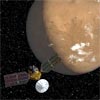
|
 |

Additional coverage for subscribers:
 VIDEO:
POST-ARRIVAL NEWS UPDATE DIAL-UP | BROADBAND VIDEO:
POST-ARRIVAL NEWS UPDATE DIAL-UP | BROADBAND
 VIDEO:
SPACECRAFT PHONES HOME AFTER ENTERING ORBIT PLAY VIDEO:
SPACECRAFT PHONES HOME AFTER ENTERING ORBIT PLAY
 VIDEO:
MRO BEGINS THE MARS ORBIT INSERTION PLAY VIDEO:
MRO BEGINS THE MARS ORBIT INSERTION PLAY

 VIDEO:
FRIDAY'S PRE-ARRIVAL STATUS BRIEFING DIAL-UP | BROADBAND VIDEO:
FRIDAY'S PRE-ARRIVAL STATUS BRIEFING DIAL-UP | BROADBAND
 VIDEO:
EXPLANATION OF MARS ORBIT INSERTION SEQUENCE PLAY VIDEO:
EXPLANATION OF MARS ORBIT INSERTION SEQUENCE PLAY
 VIDEO:
WEDNESDAY'S MISSION UPDATE DIAL-UP | BROADBAND VIDEO:
WEDNESDAY'S MISSION UPDATE DIAL-UP | BROADBAND
 VIDEO:
MARS ARRIVAL PREVIEW NEWS BRIEFING DIAL-UP | BROADBAND VIDEO:
MARS ARRIVAL PREVIEW NEWS BRIEFING DIAL-UP | BROADBAND
 AUDIO:
LISTEN TO THE NEWS CONFERENCE FOR IPOD AUDIO:
LISTEN TO THE NEWS CONFERENCE FOR IPOD

 VIDEO:
ATLAS 5 LAUNCHES MARS RECONNAISSANCE ORBITER PLAY VIDEO:
ATLAS 5 LAUNCHES MARS RECONNAISSANCE ORBITER PLAY
 VIDEO:
SPACECRAFT'S PRE-LAUNCH CAMPAIGN PLAY VIDEO:
SPACECRAFT'S PRE-LAUNCH CAMPAIGN PLAY
 VIDEO:
THE ROCKET IS ASSEMBLED FOR MRO PLAY VIDEO:
THE ROCKET IS ASSEMBLED FOR MRO PLAY
 VIDEO:
ATLAS 5 ROLLS TO LAUNCH PAD PLAY VIDEO:
ATLAS 5 ROLLS TO LAUNCH PAD PLAY
 MORE: MARS RECONNAISSANCE ORBITER COVERAGE MORE: MARS RECONNAISSANCE ORBITER COVERAGE
 SUBSCRIBE NOW SUBSCRIBE NOW

|
Cassini finds evidence for water on Enceladus
Pockets of liquid water may exist near the surface of Saturn's icy moon Enceladus, the apparent source of huge Yellowstone-type geysers seen erupting from the moon's south polar region by NASA's Cassini spacecraft, scientists reported Thursday. If so, Enceladus would join a very short list of bodies in the solar system with environments that could, in theory at least, support life.
 FULL STORY FULL STORY
 NASA NEWS RELEASE NASA NEWS RELEASE
 |  |

|
 |

Additional coverage for subscribers:
 VIDEO:
CASSINI EXPLORES ENCELADUS PLAY VIDEO:
CASSINI EXPLORES ENCELADUS PLAY
 VIDEO:
INTERVIEW WITH CASSINI SCIENTIST PLAY VIDEO:
INTERVIEW WITH CASSINI SCIENTIST PLAY
 SUBSCRIBE NOW SUBSCRIBE NOW

|
Enceladus the storyteller
A masterpiece of deep time and wrenching gravity, the tortured surface of Saturn's moon Enceladus and its fascinating ongoing geologic activity tell the story of the ancient and present struggles of one tiny world. This is a story that is recounted by imaging scientists in a paper published in the journal Science on Friday.
 FULL STORY FULL STORY
 |  |

|
 |
Scientists piece together the most distant explosion
It came from the edge of the visible universe, the most distant explosion ever detected. The result of a massive star collapsing into a black hole, the explosion comes from an era soon after stars and galaxies first formed, about 500 million to 1 billion years after the Big Bang.
 FULL STORY FULL STORY
 |  |
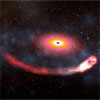
|
 |
Ultrasound on Discovery arm; Endeavour tiles hit
The shuttle Discovery's robot arm is undergoing ultrasound inspections after a weekend mishap in which a moveable access bucket bumped into the arm during work to clean up broken glass. Two small indentations were found underneath the arm's insulation blankets and NASA wants to make sure the underlying structure wasn't damaged. At the same time, engineers are assessing tile damage to the shuttle Endeavour's body flap caused by equipment that slipped off a tray used by workers inspecting the ship's rudder/speed brake.
 FULL STORY FULL STORY
 |  |

|
 |
NASA assesses unexpected reading from tank sensor
Shuttle engineers are studying what, if anything, to do about an unexpected reading from one of four liquid hydrogen main engine cutoff - ECO - sensors in Discovery's external fuel tank, officials said Tuesday. The sensors play a critical role during the climb to space by ensuring a shuttle's main engines shut down normally before draining the ship's external tank. A malfunction could trigger an early engine shutdown or let the powerplants run too long.
 FULL STORY FULL STORY
 ENGINE CUT-OFF SENSOR BACKGROUND ENGINE CUT-OFF SENSOR BACKGROUND
 |  |

|
 |
Unprecedented forecast for next sunspot cycle
The next sunspot cycle will be 30-50 percent stronger than the last one and begin as much as a year late, according to a breakthrough forecast using a computer model of solar dynamics developed by scientists at the National Center for Atmospheric Research (NCAR). Predicting the Sun's cycles accurately, years in advance, will help societies plan for active bouts of solar storms, which can slow satellite orbits, disrupt communications, and bring down power systems.
 FULL STORY FULL STORY
 |  |

|
 |
Shuttle Discovery's robotic arm examined after 'bump'
Engineers are looking under the insulation on the shuttle Discovery's robot arm to make sure an inadvertent "bump" by a moving servicing bucket didn't cause any damage.
 FULL STORY FULL STORY
 |  |

|
 |

Additional coverage for subscribers:
 VIDEO:
EARLIER FOOTAGE OF ARM BEING INSTALLED PLAY VIDEO:
EARLIER FOOTAGE OF ARM BEING INSTALLED PLAY
 MORE:
STS-121 VIDEO COVERAGE PLAY MORE:
STS-121 VIDEO COVERAGE PLAY
 SUBSCRIBE NOW SUBSCRIBE NOW

|
The air up there at Titan
This specially processed composite view from the Cassini spacecraft reveals a tremendous amount of structure in the northern polar atmosphere of Saturn's moon Titan. The hazes in Titan's atmosphere are known to extend hundreds of kilometers above the surface.
 FULL STORY FULL STORY
 |  |

|
 |
Titan shines through
Titan's smoggy atmosphere glows brilliantly in scattered sunlight, creating a thin, gleaming crescent beyond Saturn's rings. At this slight angle above the ringplane, the thin F ring shines brightly. Light from Titan's eastern and western edges penetrates the Cassini Division, which looks like a thin gap from this angle.
 FULL STORY FULL STORY
 |  |

|
 |
To the relief of Iapetus
Sunlight strikes the terminator -- the boundary between day and night -- region on Saturn's moon Iapetus at nearly horizontal angles, making visible the vertical relief of many features in this picture from NASA's Cassini spacecraft. In this image, a large, central-peaked crater is notable at the boundary between the dark material in Cassini Regio and the brighter material on the trailing hemisphere.
 FULL STORY FULL STORY
 |  |

|
 |
Space mission finds significant Antarctic ice loss
Scientists were able to conduct the first-ever gravity survey of the entire Antarctic ice sheet using data from the joint NASA/German Gravity Recovery and Climate Experiment (GRACE) satellite mission. This comprehensive study found the ice sheet's mass has decreased significantly from 2002 to 2005.
 FULL STORY FULL STORY
 |  |

|
 |
NEWSWIRE Links to news across the internet
|
 |
Two-Stage-to-Orbit 'Blackstar' System Shelved at Groom Lake? (AW&ST) -- For 16 years, Aviation Week & Space Technology has investigated myriad sightings of a two-stage-to-orbit system that could place a small military spaceplane in orbit. Considerable evidence supports the existence of such a highly classified system, and top Pentagon officials have hinted that it's "out there," but iron-clad confirmation that meets AW&ST standards has remained elusive. Now facing the possibility that this innovative "Blackstar" system may have been shelved, we elected to share what we've learned about it with our readers, rather than let an intriguing technological breakthrough vanish into "black world" history, known to only a few insiders.

SpaceX Building Reusable Crew Capsule (Space News) -- Space Exploration Technologies (SpaceX) is asking NASA to help fund the demonstration of a reusable space capsule the El Segundo, Calif.-based company has been developing in secret with its own funding for the past 18 months.
|
 |
Andromeda's origin similar to the Milky Way
For the last decade, astronomers have thought that the Andromeda galaxy, our nearest galactic neighbor, was rather different from the Milky Way. But a group of researchers have determined that the two galaxies are probably quite similar in the way they evolved, at least over their first several billion years.
 FULL STORY FULL STORY
 |  |

|
 |
Cocoons found around supergiant stars
A team of French and North American astronomers has discovered envelopes around three Cepheids, including the Pole star. This is the first time that matter is found surrounding members of
this important class of rare and very luminous stars whose luminosity varies in a very regular way. Cepheids play a crucial role in cosmology, being one of the first "steps" on the cosmic distance ladder.
 FULL STORY FULL STORY
 |  |

|
 |
Probe built to visit asteroids killed in budget snarl
A robotic mission to study two of the solar system's largest asteroids has been killed by NASA after months of uncertainty while extensive reviews probed the mission's funding and technical credentials.
 FULL STORY FULL STORY
 |  |

|
 |
A shocking surprise in Stephan's Quintet
This image of the Stephan's Quintet galaxy cluster clearly shows one of the largest shock waves ever seen (green arc). The wave was produced by one galaxy falling toward another at speeds of more than one million miles per hour. The image is made up of data from NASA's Spitzer Space Telescope and a ground-based telescope in Spain.
 FULL STORY FULL STORY
 |  |

|
 |
NASA, partners unveil new station assembly sequence
NASA and its international partners unveiled a new space station assembly sequence Thursday, one that takes into account the looming 2010 end of the shuttle program by deferring science operations in favor of construction flights to ensure completion of the orbital outpost.
 FULL STORY FULL STORY
 |  |
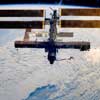
|
 |

Additional coverage for subscribers:
 VIDEO:
ISS SEQUENCE NEWS BRIEFING: DIAL-UP | BROADBAND VIDEO:
ISS SEQUENCE NEWS BRIEFING: DIAL-UP | BROADBAND
 SUBSCRIBE NOW SUBSCRIBE NOW

|
Crews begin assembling next commercial Atlas 5
Another Atlas 5 launch campaign has commenced at Cape Canaveral for a commercial satellite deployment mission slated for blastoff April 20. Assembly of the Lockheed Martin rocket started Wednesday when the 10-story tall bronze first stage was hoisted upright on the mobile launch platform.
 FULL STORY FULL STORY
 |  |

|
 |
Discovery's tank arrives at Kennedy Space Center
The external fuel tank for the next space shuttle mission sailed into Kennedy Space Center Wednesday, capping a 900-mile trip inside a covered barge from the New Orleans manufacturing plant to the Florida launch site.
 FULL STORY FULL STORY
 |  |

|
 |
Does Titan's methane originate underground?
Data from the European Space Agency's Huygens probe have been used to validate a new model of the evolution of Titan, Saturn's largest moon, showing that its methane supply may be locked away in a kind of methane-rich ice.
 FULL STORY FULL STORY
 |  |

|
 |
Mars missions mapping polar caps, impact craters
Two Mars orbiter missions - one from NASA, the other from the European Space Agency - will open new vistas in the exploration of Mars through the use of sophisticated ground-penetrating radars, providing international researchers with the first direct clues about the Red Planet's subsurface structure.
 FULL STORY FULL STORY
 |  |

|
 |
Proton rocket fails in Arab satellite launch
A Russian-made rocket booster malfunctioned during launch Tuesday, leaving an Arab telecommunications satellite below its intended Earth orbit and dealing a harsh blow to the commercial space industry.
 FULL STORY FULL STORY
 MISSION STATUS CENTER MISSION STATUS CENTER
 |  |

|
 |
Shuttle boss 'optimistic' about three flights in '06
If NASA can get the shuttle Discovery off the ground on the second post-Columbia mission this spring or summer, the agency will have a realistic shot at launching three flights this year, program manager Wayne Hale told reporters Tuesday.
 FULL STORY FULL STORY
 |  |

|
 |

Additional coverage for subscribers:
 VIDEO:
TUESDAY'S SPACE SHUTTLE PROGRAM NEWS BRIEFING VIDEO:
TUESDAY'S SPACE SHUTTLE PROGRAM NEWS BRIEFING
DIAL-UP: part 1 and part 2 | BROADBAND: part 1 and part 2

 SUBSCRIBE NOW SUBSCRIBE NOW

|
|
Read our earlier news archive page.
|



